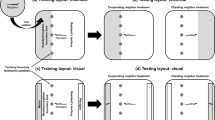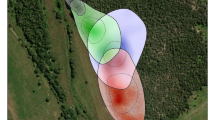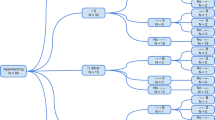Summary
Motivation to fight and willingness to risk the use of dangerous weapons, two factors which can be decisive in predicting the winners of asymmetric animal contests, are readily bluffed in display. When contests are decided by motivation to fight or “daring”, more reliable information about contest asymmetries may be gained by watching actual fights than by watching displays. By presenting mounts to territorial red-winged blackbirds and scoring how aggressively a territory holder attacks the mount, then recording any subsequent intrusions over established boundaries, I showed that neighbors are likely to intrude upon focal males that fail to attack the mount vigorously. This result suggests that red-winged blackbirds watch contests to assess the RHP of neighbors.
Similar content being viewed by others
References
Barlow GW, Rogers W, Fraley N (1986) Do Midas cichlids win through prowess or daring? It depends. Behav Ecol Sociobiol 19:1–8
Clutton-Brock TH, Albon SD (1979) The roaring of red deer and the evolution of honest advertisement. Behav 119:145–170
Clutton-Brock TH, Albon SD, Gibson RM, Guinness FE (1979) The logical stag: adaptive aspects of fighting in red deer (Cervus elaphus L.). Anim Behav 27:211–225
Davies NB, Halliday TR (1978) Deep croaks and fighting assessment in toads Bufo bufo. Nature 391:56–58
Ewald PW, Rohwer S (1982) Effects of supplemental feeding on timing of breeding, clutch-size and polygyny in red-winged blackbirds Agelaius phoeniceus. J Anim Ecol 51:429–450
Hansen AJ, Rohwer S (1986) Coverable badges and resource defence in birds. Anim Behav 34:69–76
Mason JR, Reidinger RF (1981) Effects of social facilitation and observational learning on feeding behavior of the red-winged blackbird (Agelaius phoeniceus). Auk 98:778–784
Mason JR, Reidinger RF (1982) Observational learning of food aversions in red-winged blackbirds (Agelaius phoeniceus). Auk 99:548–554
Maynard Smith J (1974) The theory of games and the evolution of animal conflicts. J Theor Biol 47:209–221
Maynard Smith J (1976) Evolution and the theory of games. Am Sci 64:41–45
Maynard Smith J, Parker GA (1976) The logic of asymmetric contests. Anim Behav 24:159–175
Maynard Smith J, Price GR (1973) The logic of animal conflict. Nature (Lond) 246:15–18
Morton CS (1977) On the occurrence and significance of motivation-structural rules in some birds and mammal sounds. Am Nat 981:855–869
Orians GH (1980) Some adaptations of marsh-nesting blackbirds. Princeton Univ Press, Princeton
Orians GH, Christman GM (1968) A comparative study of the behavior of Red-winged, Tricolored, and Yellow-headed blackbirds. Univ Cal Publ Zool 85:1–81
Parker GA (1974) Assessment strategy and the evolution of fighting behaviour. J Theor Biol 47:223–243
Parker GA, Rubenstein DI (1981) Role assessment, reserve strategy, and acquisition of information in asymmetric animal conflicts. Anim Behav 29:221–240
Rohwer S (1978) Passerine subadult plumages and the deceptive acquisition of resources: test of a critical assumption. Condor 80:173–179
Rohwer S (1982) The evolution of reliable and unreliable badges of fighting ability. Am Zool 22:531–546
Rohwer S, Ewald PW, Rohwer FC (1981) Variation in size, appearance, and dominance within and among the sex and age classes of Harris' sparrows. J Field Ornith 52:291–303
Røskaft E, Rohwer S (1987) An experimental study of the function of the red epaulettes and the black body colour of male red-winged blackbirds.Anim Behav 35:1070–1077
Searcy WA (1979a) Male characteristics and pairing success in red-winged blackbirds. Auk 96:353–363
Searcy WA (1979b) Sexual selection and body size in male red-winged blackbirds. Evol 33:649–661
Author information
Authors and Affiliations
Rights and permissions
About this article
Cite this article
Freeman, S. Male red-winged blackbirds (Agelaius phoeniceus) assess the RHP of neighbors by watching contests. Behav Ecol Sociobiol 21, 307–311 (1987). https://doi.org/10.1007/BF00299968
Received:
Accepted:
Issue Date:
DOI: https://doi.org/10.1007/BF00299968




